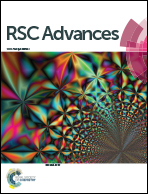Intercalation of sulfate anions into a Zn–Al layered double hydroxide: their synthesis and application in Zn–Ni secondary batteries
Abstract
ZnAl–SO4-LDH was prepared via an anion-exchange process using ZnAl–CO3-LDH as a precursor. Based on the analysis for the main characteristic peaks and intensity of the Fourier transform infrared (FT-IR) spectra, CO32− was successfully replaced with SO42−. The powder X-ray diffraction (XRD) patterns indicated that all the products were well-crystallized and the scanning electron microscopy (SEM) images showed the clear layered structure of ZnAl–SO4-LDH. This means during the anion exchange process, the framework of LDH was not affected. The electrochemical performance of ZnAl–SO4-LDH was examined by galvanostatic cycling and cyclic voltammetry (CV) measurements, and the results demonstrate a novel active material ZnAl–SO4-LDH for nickel–zinc secondary batteries with remarkable properties, including higher electrochemical activity than ZnAl–CO3-LDH and desirable cycling stability over 200 cycles (retention rate 93.2%).


 Please wait while we load your content...
Please wait while we load your content...